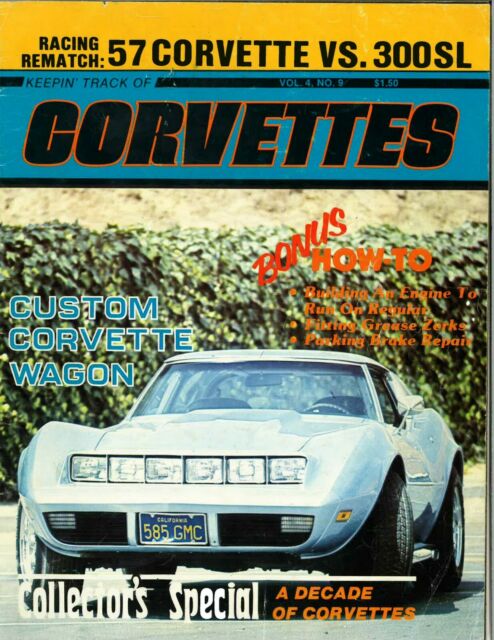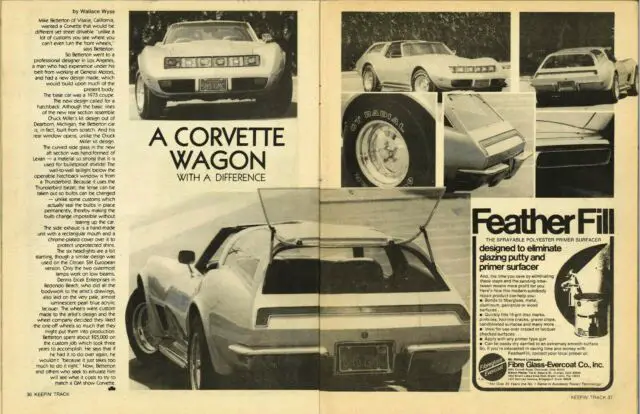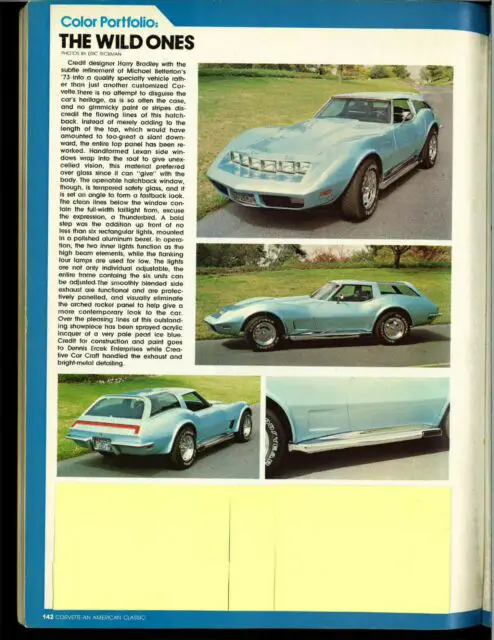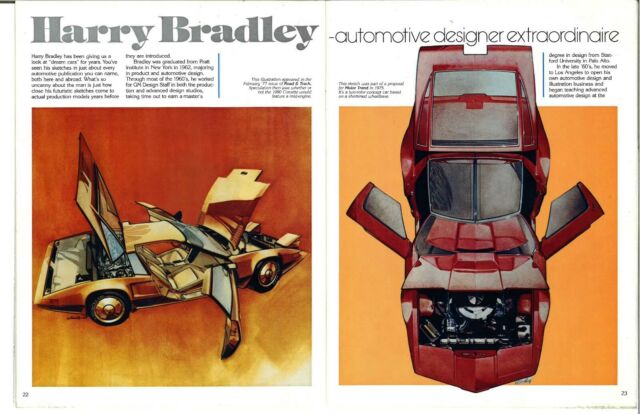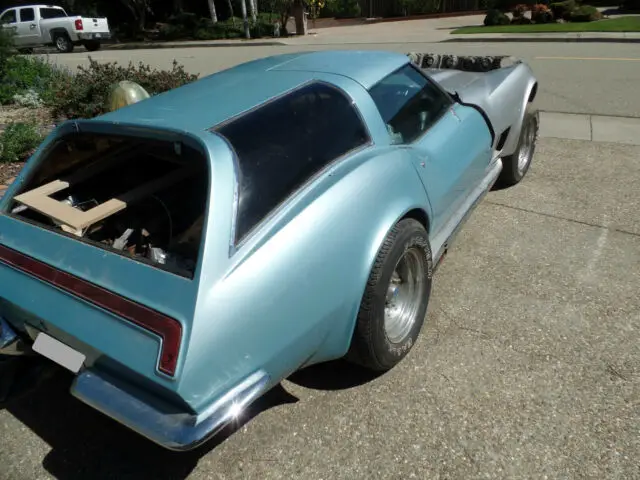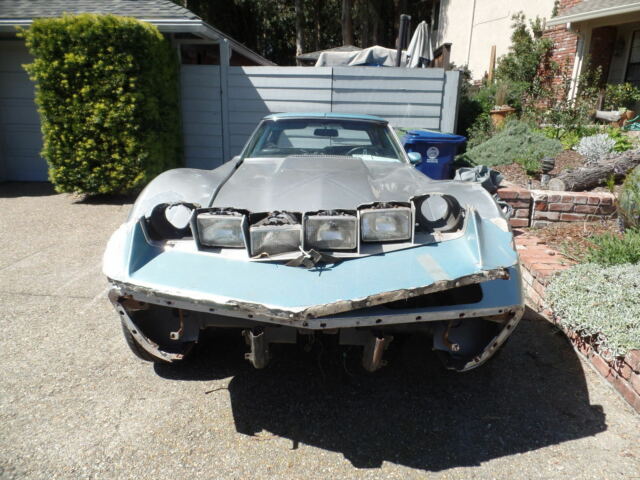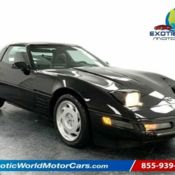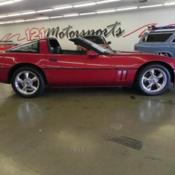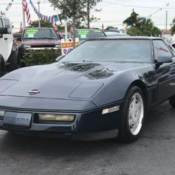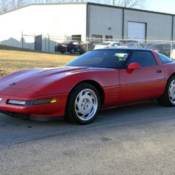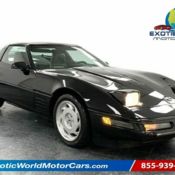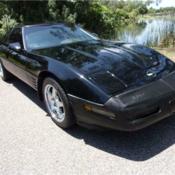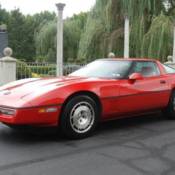One of a Kind 1973 Harry Bradley Corvette Hatchback
Price: US $19,999.00
Item location: Castro Valley, California, United States
Description:
1973 Chevrolet Corvette Custom
This is not a kit car, but a truly one-of-a-kind custom Corvette designed by Harry Bradley.Who Was Harry Bradley:
He was a designer for GM, who was then hired by Mattel to design 11 of 16 first edition Hot Wheels. He later taught at the Art Center College of Design in Pasadena, CA for 35 yrs.In 1973, this Corvette wagon was designed by Mr. Bradley, which took three years to build at a cost of $25,000.
History:
When Harry Bradley sets out to design a car, he doesn't fool around with the ambiguous or the vague. There are no superfluous add-ons or pieced-together attempts at an avant-garde style. A Bradley creation is an integrated unit, a concept that stands by itself. And, in the case of this Bradley-designed 1973 Corvette Hatchback Coupe, the end result is a work of art.
In Harry's words, "This Corvette Hatchback Coupe was designed and constructed to give the owner a vehicle that was as close to a factory prototype as possible. The intent was to develop a quality specialty vehicle, not another Corvette custom car."
Typical of the Detroit-oriented fabrication techniques that are found throughout the car, the fastback profile starts just above the rear bumpers for a completely balanced design. The rear window slopes forward and the entire roof has been reshaped and extended back. The side windows are tinted Lexan and are mounted in recessed openings. California Glass Bending, which did all the glass work, fastened these windows into position with both adhesive and special fiber nuts so that they will "give" rather than be rigid. The quarter windows wrap up and over the roof, letting light into the interior. The rear windows is tinted, tempered glass that has been framed in a chromed "U" channel, and the bright moldings were handmade from brass. The windows, also, were handmade, using special hardwood and aluminum molds.
The new roof section was built around a steel roll cage. Completely self-contained, the assembly bolts to the existing chassis using rubber mounting cushions, which permit the new roof area to flex and yield with the entire car, and the roof panels are still removable.
Bud's Garage in Torrance, California did the electrical work, including the use of the 1971 Thunderbird taillight at the rear. The taillight was narrowed 6 1/2 inches and fits into the inner housing that permits and complete access to all wiring and bulbs. The aluminum and square-tube subframe allows adjustment of the taillight assembly in the body. All of the elements are adjustable. The stock exhaust tips were eliminated, the openings in the lower panel filled, and an electric antenna (Mercedes) retracts into the left rear fender.
The front end modifications include six rectangular G.M. headlights that were placed in a horizontal row to form a "light bar." The system is totally legal, with the outer four headlights operating normally (as on any production vehicle with quad headlights) and the two inboard headlights operating on high beam by activating a separate switch, so the car may be driven with either four or six headlights in the high-beam mode. All six headlights are fully adjustable. Because there are so many polished planes, the headlights reflect over and over, giving a hall-of-mirrors effect.
A square-tube steel frame is the basis for the headlight opening, and fiberglass was laminated to this framework. The front bumper guards and license plate opening were trimmed with polished hand-formed aluminum panels. The edges of the panels were rolled to provide accent highlights, and the fresh-air vents on the hood were filled flush.
Few modifications were made to the side of the body. This machine was designed as a Corvette show car from the beginning, and no attempts were made to restyle or disguise the main Chevrolet design elements. The Corvette's full contours were maintained, not reshaped.
The side pipes ad bright metal detailing were done by the Creative Car Craft in Hawthorne. The pipes were functional units that were covered by styled, hand-formed steel shrouds to visually "stabilize" the lower body. The clean, long, horizontal shape of these shrouds establishes a straight lower line on the automobile, which overcomes the original broken rocker panel contour and gives the car a more contemporary look. The exhaust tips are not functional, and the exhaust gasses are actually directed down, not out. This protects the passengers' legs and feet from high temperatures and further muffles exhaust noises. The rear door outline at the "B" post was recut to slope up, parallel with the fenderline.
The rear floor was designed to be smooth for storage of small items. It was formed over a space-frame structure, and a modified Camaro gas tank was suspended below the grid, with the filler neck accessible behind the hinged license plate. The slight spoiler across the back of the roof aids in the aerodynamic flow of the Corvette and also keeps the backlight area clean and relatively dirt-free by creating air circulation across the glass surface.
As the rear fenders sweep back, they taper into the body sides and disappear, which is a repeat of the front fender design and creates a tight style rather than the appearance that the roof has been stacked atop the main body.
The rear window opens using handmade hinges and lift pistons that latch and lock. A Pantera lock cylinder was used as part of the locking unit. The hinges are adjustable to allow movement both vertically and horizontally, ensuring a tight fit of the backlight.
The paint is very pale, pearl-ice-blue acrylic lacquer and was done by Dennis Ereck Enterprises in Redondo Beach, which also did all the engineering and bodywork. This coloration is quite unique because it is a pure pale blue, with no green (cool) or purple (warm) highlights. Because the car's overall design is so coherent, no pin-stripingwas used.
All of the interior areas were retrimmed by Warren Morimoto of Torrance to continue the Detroit-prototype scheme. The usual "over-sophisticated", puffy interior look that is so often seen on custom cars was avoided in favor of trim, graphic upholstery work. Black vinyl and cloth (original Corvette materials) were used, and many "imitation" upholsteryareas were eliminated and replaced with real, hand-sewnwork, such as on the center console.
Double-overlapping aluminum plates on the doors and rear panel provide interior accents. The panels are beveled, include the original owner's initials, and they are themselves accented by the introduction of the exterior color.
The Corvette Hatchback is powered by a stock 350 V-8 that carries Edelbrock valve covers and intake manifold. The car is air conditioned, and the transmission is a four-speed manual. The suspension is stock, but the wheels were specifically made by Cragar Industriesmade to the artist's design and Cragar decided they liked the one off wheels so much they might put them into production. They are 8 x 15 inch Cragar SST chrome items that are shod with Goodyear GT radials in the GR/70 x 15 size.
There is a multitude of custom Corvettes on the roads these days, each of them as distinct from the stock models as Lafite-Rothschild is distinct from other fine wines, but there are few machines of any marque that could be compared to this Corvette Hatchback in terms of styling unity. Harry Bradley is a virtuoso, and his craft has produced a masterpiece in this automobile.
Car details:
The car has a matching #350 block engine.The car was in an accident in 1997 and has not been on the road since. It requires a complete front to rear restoration, including the steering, body, and drive train. The photos show the car in both it's original and current condition.Itis presently not drivable, but has been stored for over 20 years and has a clean title.With the proper restoration, this car will be the museum piece it deserves to be, and could be easily worth six figures.
This car is fully documented in numerous magazines & books like Keepin' Track of Corvettes Vol. 4 (Front Cover), Super Chevy Oct. 1978 (Front Cover), Corvette News Summer Issue 1982 (Harry Bradley's Concept Cars) & Petersen Deluxe Corvette an American Classic 1978.Harry Bradley cars have won many awards and his cars are displayed in museums and car shows throughout the country.
Transaction details:
Payment is within 14 days of purchase. Buyer is responsible for all post-sale transportation and logistics for the car. Car is located in the San Francisco Bay Area.
Vehicle Details:
- Condition: Used
- Make: Chevrolet
- Model: Corvette
- Type: Hatchback
- Trim: Custom
- Year: 1973
- Mileage: 85000
- VIN: 1Z37J3S404240
- Color: Pearl ice blue
- Engine size: 350 V-8
- Number of cylinders: 8
- Power options: Air Conditioning
- Fuel: Gasoline
- Transmission: Manual
- Drive type: 2WD
- Interior color: Black
- Drive side: Left-hand drive
- Vehicle Title: Rebuilt, Rebuildable & Reconstructed Want to buy? Contact seller!
